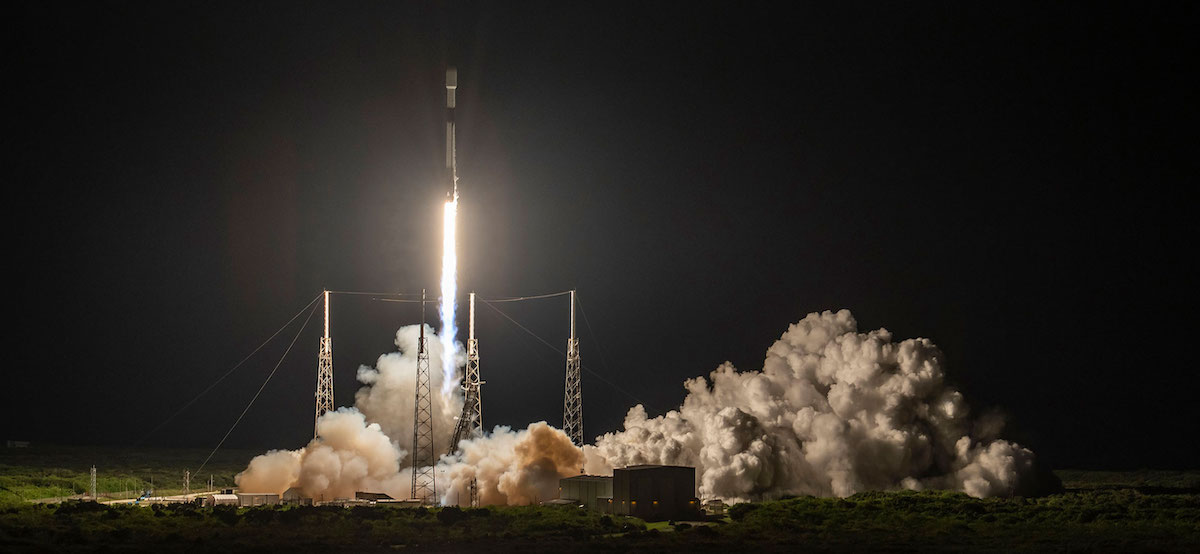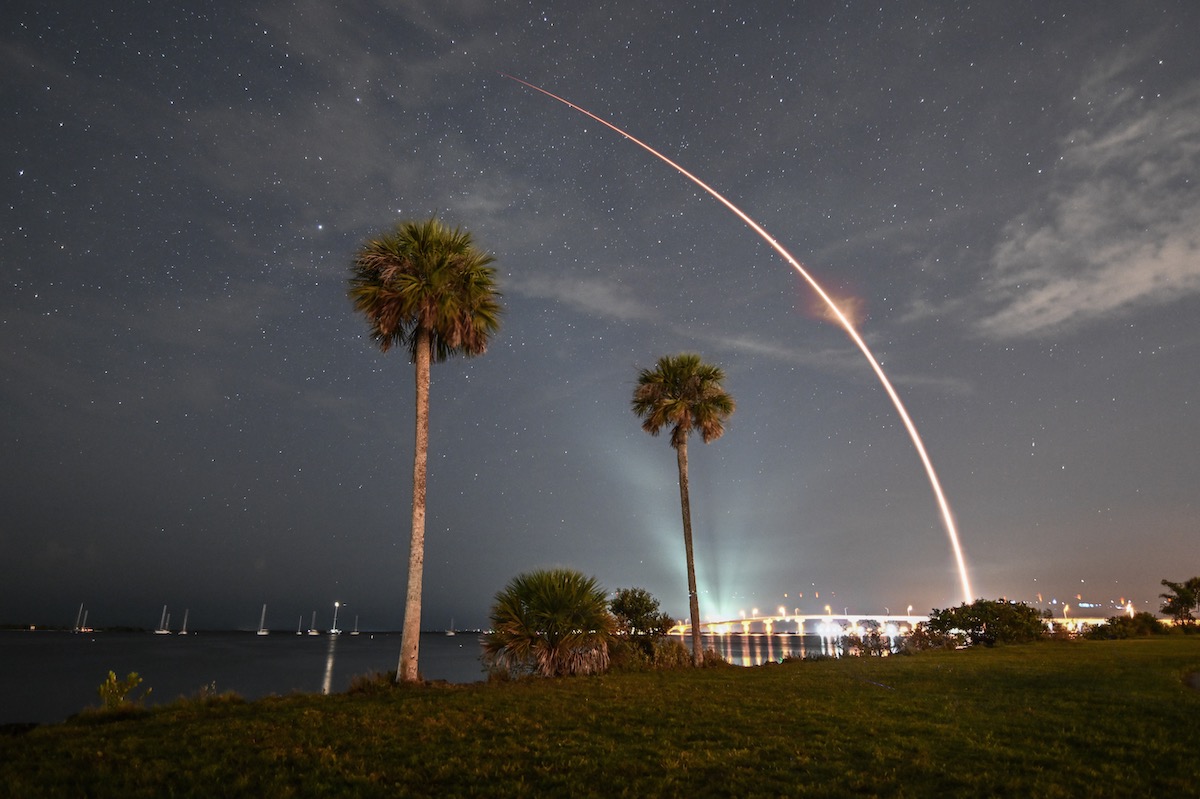Space News & Blog Articles
SpaceX launches third Falcon 9 rocket in less than two days
 A Falcon 9 rocket lifts off from pad 40 at Cape Canaveral Space Force Station with the Globalstar FM15 satellite. Credit: SpaceX
A Falcon 9 rocket lifts off from pad 40 at Cape Canaveral Space Force Station with the Globalstar FM15 satellite. Credit: SpaceX
SpaceX hauled a Globalstar communications satellite into orbit early Sunday from Cape Canaveral, pulling off the third Falcon 9 rocket flight in 36 hours, the fastest sequence of three missions
by any commercial launch company in history.
A spare spacecraft built more than a decade ago for Globalstar’s satellite phone and messaging network was tucked inside the Falcon 9 rocket’s payload shroud for liftoff from Cape Canaveral Space Force Station at 12:27:36 a.m. EDT (0427:36 GMT).
The Falcon 9 shot off the launch pad at Cape Canaveral with 1.7 million pounds of thrust from nine Merlin main engines. The engines vectored their nozzles to guide the 229-foot-tall (70-meter) rocket northeast from Florida’s Space Coast, lining up with an orbital plane in Globalstar’s satellite fleet.
The rocket surpassed the speed of sound in about one minute, and shut down its booster stage about two-and-a-half minutes into the flight. A few seconds later, the booster dropped away to head toward a SpaceX recovery platform, or drone ship, parked in the Atlantic Ocean east of Charleston, South Carolina.
The Falcon 9’s first stage — itself 15 stories tall — landed on the drone ship about 10 minutes after liftoff, adding a ninth trip to space to the booster’s logbook.
The upper stage of the Falcon 9 rocket fired its single Merlin engine three times, stepping through different orbits before finally reaching an altitude of about 700 miles (1,126 kilometers) to deploy the Globalstar FM15 communications satellite nearly two hours into the mission.
SpaceX said the upper stage reached the mission’s target orbit, and officials celebrated the company’s third successful launch in less than two days.
 SpaceX’s Falcon 9 rocket streaks through the night sky after liftoff from Cape Canaveral at 12:27 a.m. EDT (0427 GM) Sunday. Credit: Michael Cain / Spaceflight Now / Coldlife Photography
SpaceX’s Falcon 9 rocket streaks through the night sky after liftoff from Cape Canaveral at 12:27 a.m. EDT (0427 GM) Sunday. Credit: Michael Cain / Spaceflight Now / Coldlife Photography
The trifecta of Falcon 9 missions began at 12:09 p.m. EDT (1609 GMT) Friday with the launch of 53 Starlink internet satellites from the Kennedy Space Center. That mission set a record with the 13th flight of a reusable Falcon booster, which returned to a landing on one of SpaceX’s drone ships in the Atlantic.
SpaceX teams at Vandenberg Space Force Base in California launched another Falcon 9 rocket at 10:19 a.m. EDT (7:19 a.m. PDT; 1419 GMT) Saturday with the German military’s SARah 1 radar reconnaissance satellite. The Falcon booster used on the SARah 1 descended back Vandenberg for an onshore landing.
With Sunday’s mission for Globalstar, SpaceX notched three Falcon 9 flights in 36 hours, 18 minutes, the shortest span between three missions that any commercial rocket company has achieved.
The launches marked the 158th, 159th, and 160th flights of a Falcon 9 rocket overall, and the 24th, 25th, and 26th Falcon 9 missions this year, trying the 26-launch tally SpaceX achieved in the entire year of 2020. SpaceX is on pace to surpass the 31-launch mark — its total from last year — by the end of July.
Company officials are aiming for more than 50 Falcon 9 and Falcon Heavy launches in 2022.
Some aspects of Sunday’s launch caused observers to raise questions about other spacecraft that may have been deployed alongside the Globalstar satellite.
SpaceX did not mention any other payloads in its live launch webcast or on the Globalstar mission page on its website.
But the relatively light weight of the Globalstar satellite would typically leave enough propellant reserve on the Falcon 9’s booster to return to landing. Instead, Sunday’s mission featured a landing on SpaceX’s offshore recovery platform.
The live webcast of Sunday’s launch provided by SpaceX did not show any on-board camera views of the Globalstar satellite until an hour into the mission, an unusual practice for SpaceX’s commercial launches. When the live on-board camera views began airing live, the Globalstar satellite was visible mounted to a structure on the upper stage appeared to be designed to accommodate other payloads.
If there were additional satellites on Sunday’s launch, they were already deployed from the Falcon 9 rocket when the live camera views began showing on SpaceX’s webcast.
SpaceX’s Falcon 9 booster has landed on the drone ship, completing the ninth trip to space for this reusable vehicle.
This marks the third launch & landing of a Falcon 9 rocket in just 36 hours, the shortest span between three missions in SpaceX history.https://t.co/qDgQDTX6yT pic.twitter.com/lWZ1hVXfjE
— Spaceflight Now (@SpaceflightNow) June 19, 2022
In an another unusual move, Globalstar did not acknowledge any details about the launch of its spare satellite in advance of Sunday’s mission. Globalstar released a statement in a quarterly financial report last month that said it planned to launch the backup spacecraft in the “near future.” At the time, the company did not identify the launcher for the spare satellite.
The launch Sunday was the first for a Globalstar satellite since 2013, and adds capacity for the company’s commercial network providing voice and data connectivity for satellite phones, asset tracking, and internet-of-things applications.
Globalstar operates a fleet of dozens of communications satellites in low Earth orbit. The company did not respond to multiple requests for details on the upcoming launch.
The company launched 60 first-generation satellites, built by Space Systems/Loral, on Delta 2 and Soyuz rockets from 1998 through 2007. Globalstar added 24 second-generation satellites, manufactured by Thales Alenia Space, on four Soyuz rocket missions from 2010 through 2013.
The Globalstar satellites provide data connectivity for customers between 70 degrees north and south latitude, and the company’s second-generation spacecraft are designed for operational lifetimes of 15 years. The Thales-built Globalstar satellites are trapezoidal in shape and feature 16 transponders in C-band and S-band and 16 receivers in L-band and C-band.
 SpaceX’s patch for the Globalstar FM15 mission. Credit: SpaceX
SpaceX’s patch for the Globalstar FM15 mission. Credit: SpaceX
Globalstar is a competitor in the satellite phone and data relay market with companies like Iridium, Inmarsat, and Orbcomm. Globalstar announced in February it is purchasing 17 new satellites from an industry team led by MDA and Rocket Lab to extend the life of its constellation.
The company expects all of the 17 new satellites will be launched by the end of 2025. A launch service provider for the new satellites hasn’t been announced.
The $327 million contract for the 17 new satellites is being primarily funded by an unnamed “potential customer” for Globalstar’s services.
Globalstar has not disclosed the organization funding the new satellites, but the operator said last month it has signed a term sheet with a “large, global customer” to begin deploying S-band services in the so-called “Band 53” range of frequencies in the United States and in other countries.
The unnamed customer also paid for the majority of the costs associated with launching the Globalstar FM15 satellite, Globalstar said in its financial filings with the Securities and Exchange Commission.
Globalstar FM15 separation confirmed. A spare satellite for Globalstar’s commercial voice and data relay constellation has deployed from SpaceX’s Falcon 9 rocket at an altitude of 700 miles (1,126 kilometers). https://t.co/qDgQDTX6yT pic.twitter.com/xMlve1ff1R
— Spaceflight Now (@SpaceflightNow) June 19, 2022
SpaceX plans two more Falcon 9 launches this month.
Another batch of Starlink internet satellites is scheduled to take off from the Kennedy Space Center next Saturday, June 25. And a Falcon 9 rocket is being readied for launch June 28 from pad 40 at Cape Canaveral with the SES 22 television broadcasting satellite.
This email address is being protected from spambots. You need JavaScript enabled to view it. the author.
Follow Stephen Clark on Twitter: @StephenClark1.
When you subscribe to the SpaceZE News Feed, we will send you an e-mail when there are new updates on the site so you wouldn't miss them.

